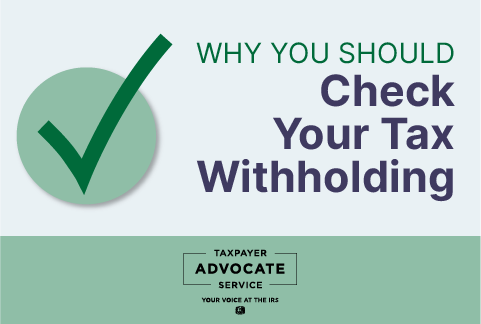

It is a good practice for everyone to do a paycheck check-up every year. Checking your tax withholding amounts can ensure that you aren’t paying too much or too little in federal income tax though a nice, big refund is a welcome surprise.
But, no one likes surprises come tax time. Checking your tax withholding amounts can ensure that you aren’t paying too much (or too little) in federal income tax. Doing a paycheck check-up is a great way to prepare for Tax Day – even if you just filed your taxes.
Federal income tax is a pay-as-you-go tax. That means that throughout the year, you pay or have an employer, or the payer of income, withhold a portion of your taxes as you earn or receive income.
It is a good practice for everyone to do a paycheck check-up every year.
There are essentially two ways to pay your federal income taxes:
If you don’t pay enough taxes during the year, you could be subject to estimated tax penalties. Typically, you can avoid a penalty and any applicable interest by paying at least 90 percent of your taxes during the year.
Checking and then adjusting tax withholding can help make sure you:
- Don’t owe more tax than you are expecting;
- Don’t get a surprise tax bill, and possibly a penalty, when filing next year; or
- Don’t receive a refund that is much larger or smaller than anticipated.
To avoid a large or unexpected tax bill it is also a good idea to change your withholding when you experience a big life change such as marriage, divorce, birth of a child, getting a new or second job, starting a side business, or receiving any other income that isn’t subject to withholding.
It’s important to do this as early in the year as possible, so that if a tax withholding adjustment is needed, there is more time to make up the difference during the rest of the year. Waiting means there are fewer pay periods to withhold the necessary federal tax.
The IRS Withholding Estimator on IRS.gov is a free tool that can help you calculate the right amount of tax to withhold from your paycheck.
The Estimator works for most taxpayers; however, people with more complex tax situations should use the instructions in Publication 505, Tax Withholding and Estimated Tax.
This includes taxpayers who owe:
If you think you need to make changes to your withholding amount, the withholding estimator gives you the information you will need to fill out a new Form W–4, Employee’s Withholding Allowance Certificate. Because this form tells your employer how much you want them to withhold, submit the new W-4 to your employer as soon as possible to make the changes. Some payroll providers allow you to adjust your withholding using an online version of the Form W-4.
If after making withholding adjustments, the amount of income tax withheld from your salary or pension is not enough, or if you don’t have any withholdings at all, you may have to make estimated tax payments. This also applies if you receive income such as interest, dividends, alimony, capital gains, prizes and awards, or other sources of income without withholding. You might also need to make estimated tax payments if you are in business for yourself.
Estimated tax payments are due four times each year:
Note: If these due dates fall on a Saturday, Sunday, or legal holiday, the payments are due the next business day.
Your estimated tax payments should correspond to the period that any income is received. If you don’t pay enough tax by the due date of each of the payment periods, you may be charged a penalty even if you are due a refund when you file your income tax return.
You can use the worksheet in Form 1040-ES to figure your estimated tax. Again, it’s a good idea to do this each year, as early in the year as possible.
If you are unemployed and receive unemployment compensation, you may choose to have a flat ten percent withheld from your unemployment benefits to cover all or part of your tax liability.
Remember, if you need to increase your withholding, even just adding a few dollars more or making a partial estimated tax payment can make a difference in the amount you may owe on your tax return. For those who cannot afford to pay taxes through their withholding or estimated tax payments, the IRS has payment options available. Each option has different requirements, and some have fees.
Most options for paying off a tax debt work best if you are proactive. More information is available on our I Can’t Pay My Taxes Get Help Page.
Yes, all gambling winnings are taxable and must be reported as income on your tax return. This includes cash winnings and fair market value of prizes such as cars and trips from:
You should receive a Form W-2G, Certain Gambling Winnings, from a payer that shows the amount of your winnings and any taxes taken out. You must report all gambling winnings as “Other Income” on Form 1040 or Form 1040-SR , including winnings that aren’t reported on a Form W-2G. Some gambling winnings may require you to pay estimated tax.
Note: There are different rules for professional gamblers. For more information about withholding gambling winnings see Publication 505, Tax Withholding and Estimated Tax.